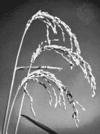- Rice
-
/ruys/, n.4. Grantland /grant"leuhnd/, 1880-1954, U.S. journalist.
* * *
IEdible starchy cereal grain and the annual grass (Oryza sativa, family Poaceae, or Gramineae) that produces it.Roughly one-half of the world's population, including almost all of East and Southeast Asia, depends on rice as its principal staple food. First cultivated in India more than 4,000 years ago, rice was planted gradually westward and is now cultivated widely in flooded fields (paddies) and river deltas of tropical, semitropical, and temperate regions. Growing to about 4 ft (1.2 m) in height, rice has long, flat leaves and an inflorescence made up of spikelets bearing flowers that produce the fruit, or grain. Removal of just the husk produces brown rice, containing 8% protein and a source of iron, calcium, and B vitamins. Removal of the bran layer leaves white rice, greatly diminished in nutrients. Enriched white rice has added B vitamins and minerals. So-called wild rice (Zizania aquatica) is a coarse annual grass of the same family whose cereal grain, now often considered a delicacy, has long been an important food of North American Indians. Rice (Oryza sativa).Grant HeilmanII(as used in expressions)Burroughs Edgar RiceRice Jerry Lee
Rice (Oryza sativa).Grant HeilmanII(as used in expressions)Burroughs Edgar RiceRice Jerry Lee* * *
▪ cereal grainedible starchy cereal grain and the plant by which it is produced. Roughly one-half of the world population, including virtually all of East and Southeast Asia, is wholly dependent upon rice as a staple food; 95 percent of the world's rice crop is eaten by humans.The cultivated rice plant, Oryza sativa, is an annual grass of the Gramineae family. It grows to about 1.2 m (4 feet) in height. The leaves are long and flattened, and its panicle, or inflorescence, is made up of spikelets bearing flowers that produce the fruit, or grain.Many cultures have evidence of early rice cultivation, including China, India, and the civilizations of Southeast Asia. However, the earliest archaeological evidence comes from central and eastern China and dates to 7000–5000 BC. With the exception of the type called upland rice, the plant is grown on submerged land in the coastal plains, tidal deltas, and river basins of tropical, semitropical, and temperate regions. The seeds are sown in prepared beds, and when the seedlings are 25 to 50 days old, they are transplanted to a field, or paddy, that has been enclosed by levees and submerged under 5 to 10 cm (2 to 4 inches) of water, remaining submerged during the growing season.The harvested rice kernel, known as paddy, or rough, rice, is enclosed by the hull, or husk. Milling usually removes both the hull and bran layers of the kernel, and a coating of glucose and talc is sometimes applied to give the kernel a glossy finish. Rice that is processed to remove only the husks, called brown rice, contains about 8 percent protein and small amounts of fats and is a source of thiamine, niacin, riboflavin, iron, and calcium. Rice that is milled to remove the bran as well is called white rice and is greatly diminished in nutrients. When white rice forms a major portion of the diet, there is a risk of beriberi, a disease resulting from a deficiency of thiamine and minerals. Parboiled white rice is processed before milling to retain most of the nutrients, and enriched rice has iron and B vitamins added to it. Rice is cooked by boiling. It is eaten alone and in a great variety of soups, side dishes, and main dishes in Oriental, Middle Eastern, and many other cuisines.The by-products of milling, including bran and rice polish (finely powdered bran and starch resulting from polishing), are used as livestock feed. Oil is processed from the bran for both food and industrial uses. Broken rice is used in brewing, distilling, and in the manufacture of starch and rice flour. Hulls are used for fuel, packing material, industrial grinding, fertilizer manufacture, and in the manufacture of an industrial chemical called furfural. The straw is used for feed, livestock bedding, roof thatching, mats, garments, packing material, and broomstraws.In the 1960s, the so-called Green Revolution, an international scientific effort to diminish the threat of world hunger, produced improved strains of numerous food crops, including that known as miracle rice. Bred for disease resistance and increased productivity, this variety is characterized by a short, sturdy stalk that minimizes loss from drooping. Poor soil conditions and other factors, however, inhibited its anticipated widespread success.The principal rice-producing countries are China, India, Japan, Bangladesh, Indonesia, Thailand, and Burma. Other important producers are Vietnam, Brazil, South Korea, the Philippines, and the United States. In the late 20th century, the world rice crop averaged between 800,000,000,000 and 950,000,000,000 pounds annually and was cultivated on an average of about 358,000,000 acres (145,000,000 hectares). See also wild rice.* * *
Universalium. 2010.
